#traditional mongolian fashion
Text
Mongolian Women Series by Artist Su Ruya.
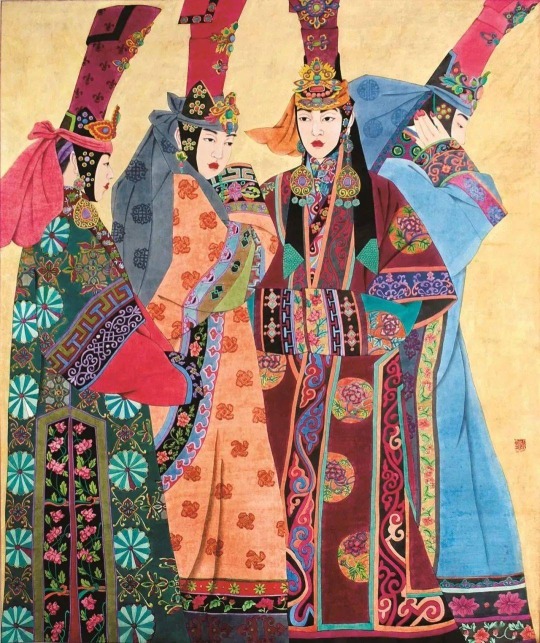
Mongolian Noble Women. Su Ruya. Painting, 2017 [image source].

Mongolian Woman No. 9, Mongolia Imagery Series. Su Ruya. Painting, 2002 [image source].

Mongolian Women No. 2, Mongolia Imagery Series. Su Ruya. Painting [image source].

Mongolian Women No. 1, Mongolia Imagery Series. Su Ruya. Painting, 1998. [image source].

Mongolian Woman No. 10, Mongolia Imagery Series. Su Ruya. Painting, 2002 [image source].
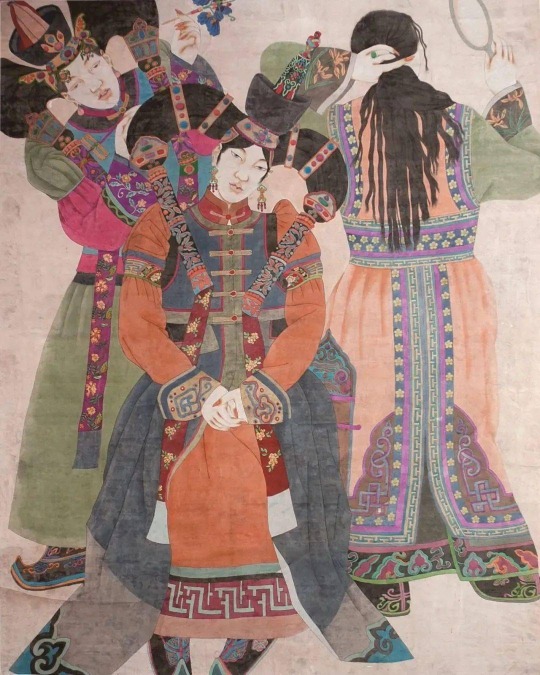
Golden Age. Su Ruya. Painting, 2014 [image source].

Mongolian Woman No. 15, Mongolia Imagery Series. Su Ruya. Painting, 2015 [image source].
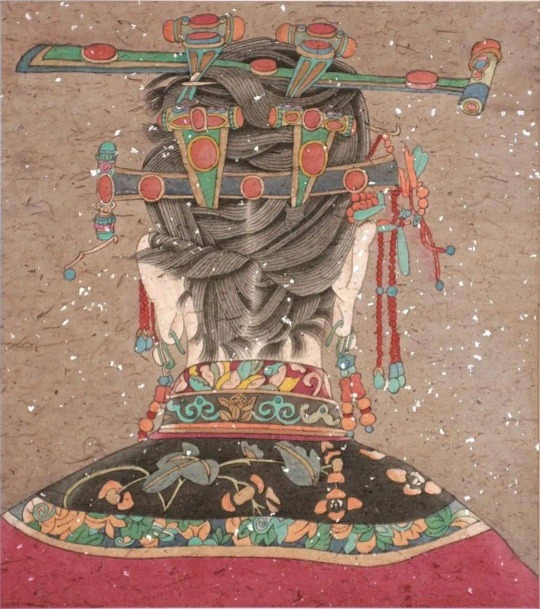
Mongolian Woman No. 5, Mongolia Imagery Series. Su Ruya. Painting, 2000 [image source].
#mongolia#inner mongolia#chinese art#china#chinese artists#inner mongolian artists#asian art#mongolian fashion#traditional mongolian fashion#su ruya#su ruya artist#painting#art#boqta#gugu hat
39 notes
·
View notes
Text
Queen Amidala – Star Wars
Although RESA have never seen a Star Wars movie, Resa did recognize this fence mural as from the franchise. Graffiti Lux Art & More – MAY 27, 2022
https://graffitiglam.files.wordpress.com/2022/05/sw5.jpg?w=640&h=391
So, I sent a pic to my main pal from this universe – Tyeth – For Tyeth Saber Site
Tyeth – “Oh wow! That is unreal! I think the artist has used the colour palette used on…
View On WordPress
#based on real life Mongolian fashion#Darth Vader#fence mural#FENCES#Master Yoda#Naboo tradition#Natalie Portman and by Keira Knightley#Padme#Queen Amidala – Star Wars#RESA - Graffiti Lux Art & More#Star Wars#the Blu-Ray edition boxes#the movie (Phantom Menace)
0 notes
Text
A dorm room showing off their traditional Mongolian clothing.
Dorm fashion (and 'fashion') shows has been a returning douyin trend for Chinese university students as they go back to school. Due to continued zero-COVID policies, as school returns, some campuses experience restrictions or campus lock-ins, leaving students to entertain themselves.
735 notes
·
View notes
Note
hello, my dearest! yes, it me again! *kneels and heavy sigh* I must know my beautiful Rhaenyra fashion. she was recorded in Fire and Blood to dress very lavish in colors, and have a lot of jewerly.
and I keep thinking of her wearing Valerian braiding, and gold hair jewelry in her braids, and beautiful silks, and pearls—- AHHHH. the show did her dirty!!
Emma is a gem, and gorgeous! And they deserved to be dressed in full on Rhaenyra attire. I even imagine Targaryen women wearing facial jewelry, like back in old Valyria, nose piercings.
She is Westeros’ It Girl, where is the luxury??? THE GAWDY BAD BITCHERY OF IT ALL???
Although I absolutely adore the wedding head piece she wore, but her dress….. I just knowwww, traditional wedding attire for Targaryens are so much more. Especially since Targaryens’ culture takes inspiration from the Byzantine empire, and Mongolian culture, and another culture!
You should’ve been in the costume department for show, we have been FAILED.
I can also imagine her in comfort furs. Especially when she would be pregnant, mamas needs to be comfy, and still serve cunt.
Yes justice for Rhaenyra 🫡 (also again with the immaculate timelines for the real life eras I gave to these time periods but this is just spitballing for fun)
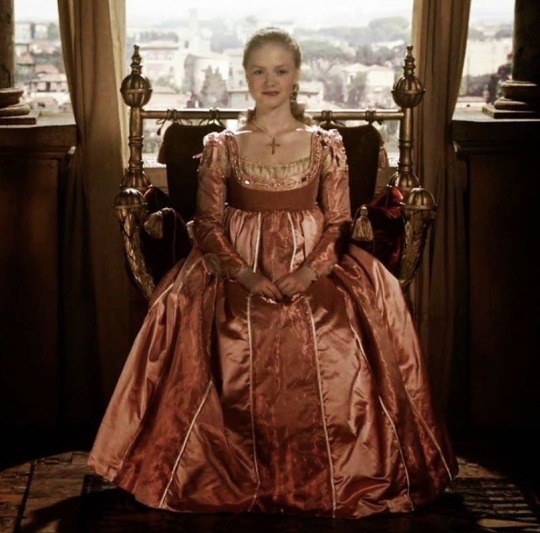


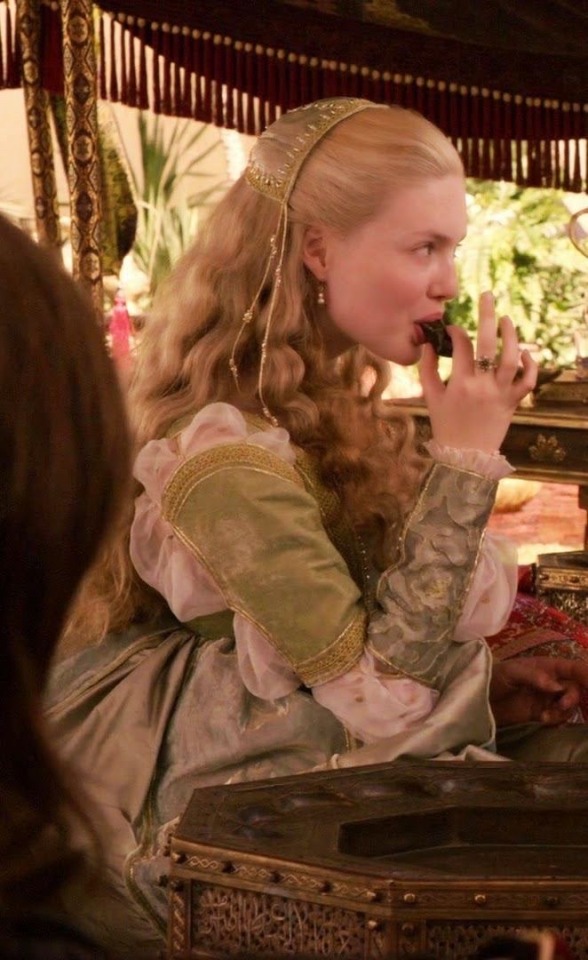
Baby Rhae my Renaissance beloved. Very light colors, she doesn’t always wear red quite yet, she likes to dress in a rainbow of the finest silks merchants have to offer. A high waist and gowns that are not super tight or defined gives her a more youthful look. In my head she likes to match with Ali so they both wear similar gowns, though Rhae’s are noticeably more grand. In her youth her hair was long and loose, covered with a cap during casual situations, braided and looped and covered with netting and pearls during balls/feasts/tourneys
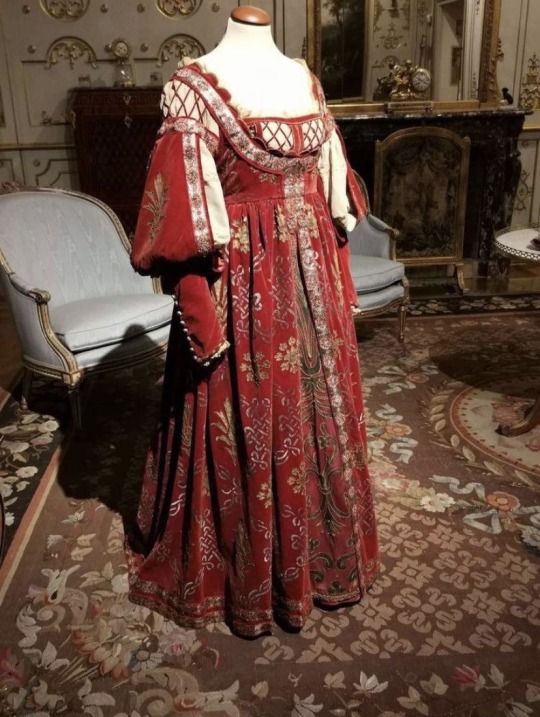


Freshly married Rhae starts wearing a lot more red, trying to really cement her claim as her fathers true heir. She still sometimes wears the gowns she used to match with Ali, however they’re more fitting to a married women, with dark colors and being slightly more fitted to her figure. Her hair is now up too, becoming for a married princess, but she still likes it to be rolled and braided, still covered with pretty things. She’s in a middle ground between childhood and womanhood

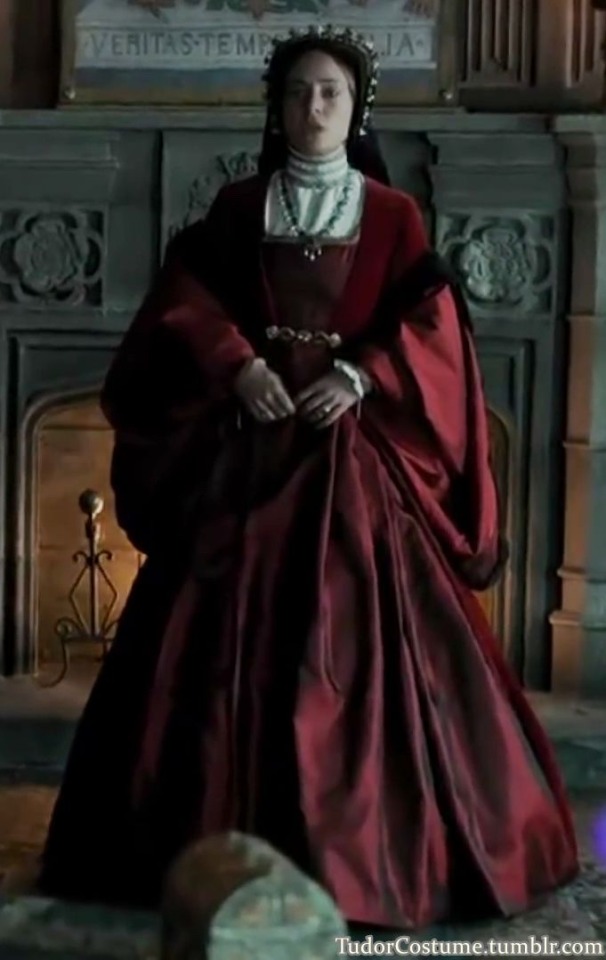

War time Rhae is when she starts becoming very “maegor with teats” she only wears red and black, loathing the color green. Her gowns are now high necked and long sleeved, stern and serious and fitting for a mourning mother. Her hair is often hidden by a hood and veil, but underneath its tightly braided and practical. No longer any signs of the youth she once was
#asoiaf#asoiaf hair and clothing#Rhae plus the cycle of targ doom makes me SICK#ur alive in my head bbg
95 notes
·
View notes
Text

Walk walk fashion baby~
I’ve made the red lotus members wear traditional costumes of what I imagine would be their ethnic group: for Zaheer I chose Zhuang Chinese and for sweetest Ghazan Mongolian!
Please keep in mind that I am in no way an expert in such cultures and I’m taking what I could find on the internet as a source. My intent is to uplift these beautiful clothes on some of my favorite characters. It is very possible I made mistakes in replicating clothes from cultures I do not know that well and I do not want in any way to offend anyone! As a matter of fact, I’d love to have some feedback from someone who does know them!
#lok fan art#lok#avatar the legend of korra#avatar#atla#ghazan#zaheer#red lotus#polycule#panseuxal#bisexual#fan art#au#art#digital drawing#digital art
184 notes
·
View notes
Text
Talking about the Qabā'. Again.
The last time I talked about the Qaba was in another post where i was very excited to have found a miniature from either Syria or Egypt that matched an extant piece of fabric from a close time period. Today I'm going to talk about the garment itself more, and it's relatives. The impetus for this is that a few months ago, I was scrolling through hanfu blogs- if you've read the article I published in Egyptian Migrations, you know I have an interest not just in Egyptian fashion, but how other cultures navigate fashion, both in their unique subcultures and traditional styles. While doing so I came across the tieli (貼裏), and quite liked the look of it, so I searched up the garment and began looking more at it. As I was scrolling through the many pretty pictures, I realized hey- I've seen this before. This looks a lot like that coat with the red foliage pattern!
Turns out this was because they're related.
They're not the only ones either- the Qabā' (as both Farsi and Arabic call it), the Tieli, the Indian Jama, the Korean Cheolik, and more, all bear a resemblance to each other. Covergent evolution happens plenty of course, but in this case there's something of an established link. In fact while doing my research, I found a paper specifically about this garment family (The Dress of the Mongol Empire: Genealogy And Diaspora of the Terlig by Woohyun Cho, Jaeyoon Yi, and Jinyoung Kim), though without explicit mention of the Qabā'.
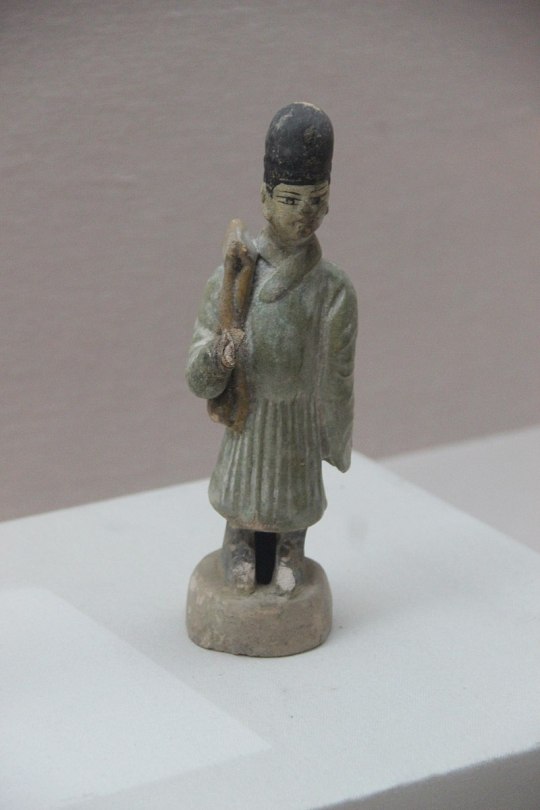

The name and garment Tieli come from the Mongolian Terlig and Jisün (also called a Zhama (诈玛 or 詐馬), establishing a possible linguistic connection to the Jama) during the Yuan dynasty. Like many Mongolian traditional garments, it's well suited to horseback riding, which which what many Mamluk depictions also show the Qabā' being worn during. It could be round or cross collar (the combination of the two is unique to the Qabā'). The key features of the garment were a knee to calf length skirt that was gathered or pleated, a close fitting bodice cut separate from the skirt, close fitting sleeves, a corded waist which usually lead into the ties that closed the garment. According to the aforementioned trio, the garment was originally made of hides, and the waist detail found in the original Terlig, lost in other cultures renditions, is an indication of this. The Terlig, known before this point, was introduced to China, India, and Korean when the Monglian Empire was an active political entity in the 13th century and onwards, and this is the case for this style of Qabā' as well. During the 13th century, the Ilkhanate was established in the former territory of the Khwarazmian Empire, after a political incident where the Shah ordered the execution of a group of merchants sent by the Mongolian Empire lead to a long military conflict. The Ilkhanate went on to control large portions of Turkey, Syria, Iraq, and the Caucasus, as well as Afghanistan, Turkmenistan, and Pakistan. Ultimately the Ilkhanate tried, but never did, conquer Egypt, which was ruled by the Mamluks at the time.
However, it did leave a cultural influence behind. Reference to this origin for this style of qaba can be found in one of the two names for the Qabā': al-aqbiya al-tatariyya or qabā' tatarī, meaning the Tatar coat or Tatar way of wearing a coat. Tatar, in this instance, is being used to refer to Mongolians. A similar distinction can be found in the Jama, where Muslims fasten it on the right in the Mongolian style (brought to my attention by the paper mentioned before). The tatarī is fastened in the same way, ties on the wearer's right of the body. The other style of Qabā' (al-aqbiya al-turkiyya) is the same, but fastens on the opposite side of the body. The Mamluks preferred the tatarī, but it was not the exclusive style worn. Along with this, some Qabā' fastened in the center front.
The Jisün was a type of Terlig, made of one color of silk and gold, worn as a robe of honor by officials during the Yuan dynasty. During the later Ming dynasty, it became the dress of certain military officials. It had different varieties for seasons and social status. It also progenitated the Yesa (曳撒), which was longer and more widely worn than the Jisün. The Feiyufu (飞鱼服) was a Ming variant of the Tieli, and another type of honor robe. The Qing dynasty Chaofu also seems to have taken the terlig into account when it was designed.

The Cheolik has a crossover collar, pleated skirt, and may have quite long, wide sleeves. Political marriages with Mongolian courts likely helped this garment take root. This garment is still worn today as Korea, like China, has revitalized its traditional clothing. It is mostly by women today as far as I can tell, though historically it was a masculine garment. It has a longer hem than the Terlig. It also sometimes had a higher waistline.
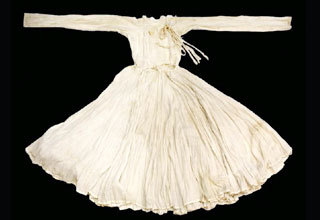
The Jama was introduced by the Mughal dynasty, and unlike the other garments listed here which typically used rectangles and triangles for constructing clothes, the one pattern I've seen for it taken from an extant garment (as opposed to being a guess) shows a skirt made of gores and set in sleeves with a gusset. Another example, laid flat, shows rectangular sleeves with a gusset, but the skirt cannot be determined. It was later renamed to sarbgati. It typically has a crossover fastening, though I have seen one that closed in the center front. The ties are especially prominent and decorated, which overall is not the case in the rest of the garment family. Gold bands on the sleeves and collar are sometimes found as decoration. It also has a longer hem and higher waistline than the Terlig.


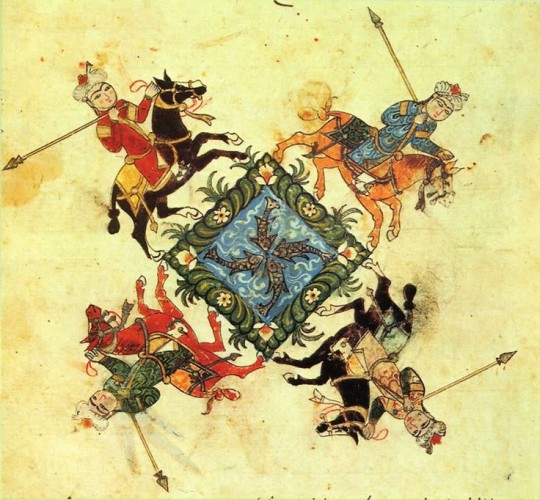
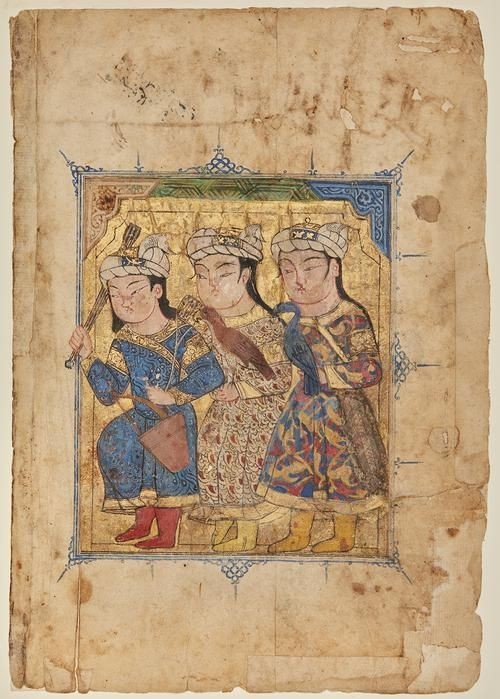
In my previous post I noted a similarly to this robe and the Central Asian and Persian robes I'd seen from a different century, but was hesitant to connect them. Now I'm sure of a connection. The waist seam is confirmed! There are still several stylistic differences, though:
1. The Qabā', in Syrian and Egyptian depictions, typically combines a round neckline with the cross over collar. The Persian Qabā' typically does not have a round neckline.
2. The Qabā' usually has what looks like a gathered skirt, not a pleated one, as the Tieli does. The Terlig sometimes has a gathered skirt as well, as does the Jama.
3. The Syrian and Egyptian Qabā' is decorated with strips of gold, not with a cloud collar. The Persian Qabā' often has a cloud collar, which it inherits from the Terlig, and I have seen an Angarkha from Lahore with a cloud collar as well. It sometimes has bands. The Seljuk Qabā' sometimes has bands, and sometimes has a rank badge (more commonly found in Chinese court dress). As an aside, I recently found a British drawing (from life, presumably) of an Egyptian envoy in a garment similar to an Angarkha as well...
4. The Qabā' in Syrian and Egyptian depictions often retains the knee or calf length good for horse riding that many other garments in this family moved away from.
5. The Qabā' most likely does not have the corded waist found in the Terlig. There is a gold band around the waist in some depictions that could be a braided waist, but could also be a belt. Unfortunately I don't know of any extant examples from Syria or Egypt that would clarify matters. There is an example which might be Persian that does show this corded waist. Most depictions have no waist detail other than an indication of a waistline.
As far as I know, while this robe spread a little into the Balkans and Eastern Europe (the cloud collar has appeared in some Christian Iconography and a few examples of Terlig like historical garments exist), it did not spread much further west or south of Egypt. However, given the Qabā' has been excluded from discussions of the Terlig's many sons already, it's possible I simply don't know about it, as further iterations in Africa would be excluded as well. As always, I welcome people bringing their own findings to the table.
Further reading: The Dress of the Mongol Empire: Genealogy And Diaspora of the Terlig by Woohyun Cho, Jaeyoon Yi, and Jinyoung Kim
Mongol court dress, identity formation, and global exchange by Eiren L. Shea
https://sartorialegypt.wordpress.com/2022/12/03/a-brief-discussion-of-a-mamluk-robe/ - prev post
http://collections.vam.ac.uk/item/O480307/gown/ - the cloud collar angarkha
https://www.newhanfu.com/6021.html - Discussion of the tieli and yesa
https://www.jstor.org/stable/41917645 - Terlig discussion
https://www.jstor.org/stable/43957434 - general discussion of Yuan clothing with a nice example of a terlig
https://en.unesco.org/silkroad/silk-road-themes/mouvable-heritage-and-museums/robe-decorative-braided-waist-band-0 - Terlig example
A Preliminary Study of Mongol Costumes in the Ming Dynasty by Luo Wei
https://m.terms.naver.com/entry.naver?cid=46671&docId=563301&categoryId=46671 - Cheolik
Arab dress: a short history; from the dawn of Islam to modern times by Yedida Stillman
https://lugatism.com/outer-garments-in-the-mamluk-sultanate/#3-_Qaba_qba - the Qaba and other dress in the Mamluk era
https://www.agakhanmuseum.org/collection/artifact/robe-AKM677 - a robe which may be Persian or Central Asian with the corded waist
Additionally, blogs like @ziseviolet and @fouryearsofshades post about hanfu, including the tieli and yesa.
138 notes
·
View notes
Note
Hello!! If it's not too much trouble, do you have any sites you'd recommend for fashion/outfit visuals besides Pinterest? I'm trying to cobble together some fashion visuals for the deity of eternity template but I've honestly just been fighting for my life during the past *checks clock*...... four hours 😔✊🏽
Underneath the readmore, I include both:
Fashion resources (links to posts with even more resources, lists, etc.)
How to find better images on Pinterest (Best done after looking at fashion resources!)
Resources
GENERAL resources - I was vehemently looking for a post I reblogged with stock free photos sites, but it's poofed ;; but I remember Pixabay, Unsplash and FreeImages being mentioned! Something very similar to Pinterest, but not copyright free, is WeHeartIt. These sites are very general, though, so it might be hard to find any actual fashion inspo.
European period-accurate fashion - Here is a post about a HUGE site where you can find period-accurate fashion! It also includes a link to an extremely extensive post on period-accurate fashion with resources such as books, blogs, sites, etc. My only gripe is that a majority of these resources are very eurocentric, but the post included a small non-western section for resources.
Uroboros-specific - I made a post all about the fashion of Uroboros here! This is good for finding fashion that is actually within Uroboros, but it is also great in general for finding keywords / search terms for fashion. You find the best resources by knowing the specific time period/fashion you want.
Hanfu - Traditionally worn by the Chinese, but it persists today! This is one of the fashion inspos of Uroboros. The sites suggested in this post will be more modern/inspired than period-accurate, but they are gorgeous! My preference is to use Taobao, a Chinese site for buying hanfu, but currently, I am unable to access it. Hence, this post has a list of non-Taobao shops.
Deel - traditional Mongolian clothing, also one of the inspiration for Uroboros (desert region). Mongulai is a Mongolian shop founded by a Mongolian man!
Once you find all the kinds of dresses you want, though, you might consider looking for them in Pinterest. You only need a general idea of what you want, not extensive knowledge on it--so you might not want to sift through actual books!
For that, equipped with knowing what you want, the best way to get a lot of images quickly is by
Finding things on Pinterest
Finding things on Pinterest is great for general ideas, but the best things you get on Pinterest is by being specific. I already know I want Rococo, Song style hanfu, and some paintings/vibes/aesthetic, so I'll start searching up those things.
Once I find an image I like and save it, Pinterest learns what I like and starts recommending me things through my feed that are even more accurate to what I'm looking for. And of course, clicking on that Pin will suggest other Pins like it, which sends you down the rabbit hole of finding things. This is how I get 90% of the images I have, with only 10% of it being directly searched.
Here's an example of just searching for vibes/aesthetic. I start my search with "ethereal aesthetic", nature aesthetic, and "marble statues aesthetic":
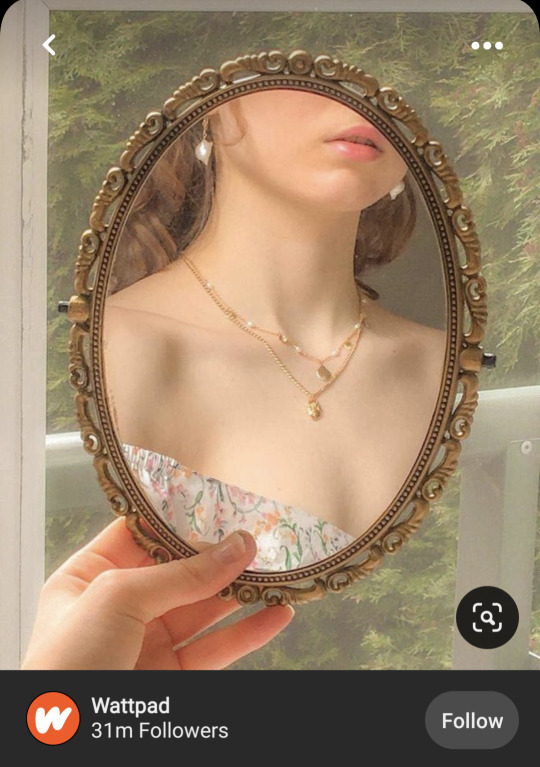
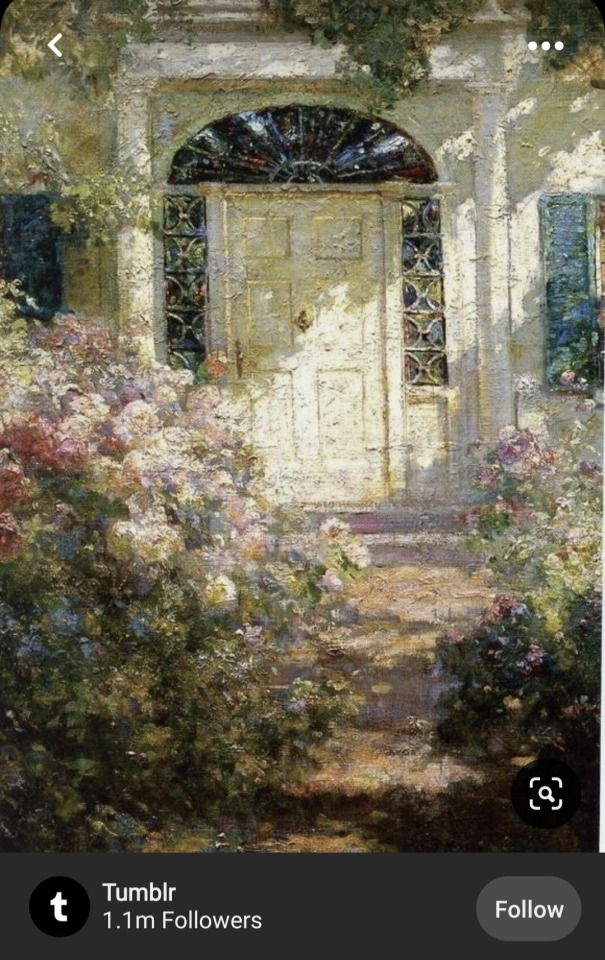
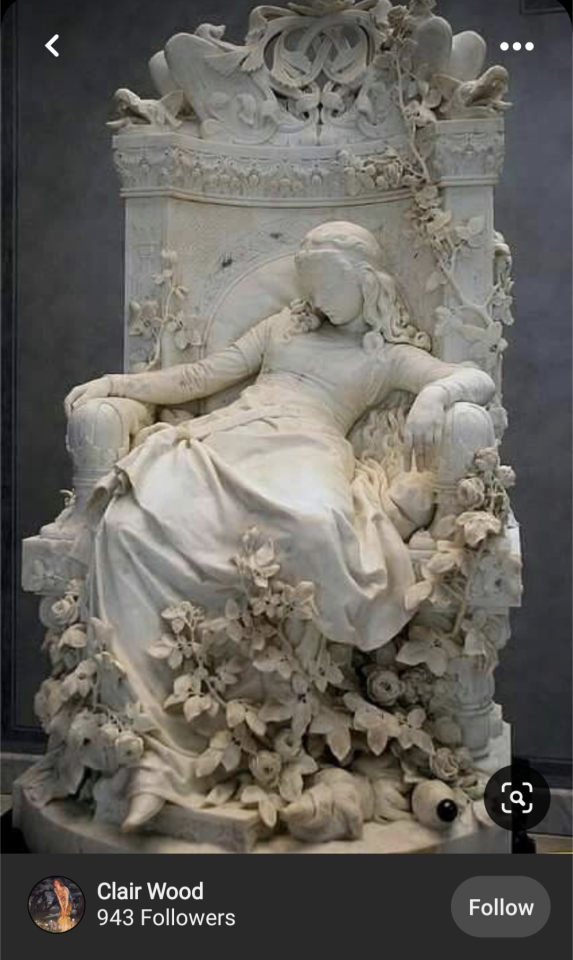
It took a couple of minutes of scrolling to find these after looking through the search results, since my search terms were relatively general.
After saving only a few images, I went back to the feed and it started suggesting me some pretty similar things:


However, when you know SPECIFIC things you want (after looking at the resources I suggested), you get even better results just from searching (in addition to having amazing suggestions from your feed).
Here, I looked up "Rococo paintings," "Mediterranean aesthetic," and "Song style hanfu":
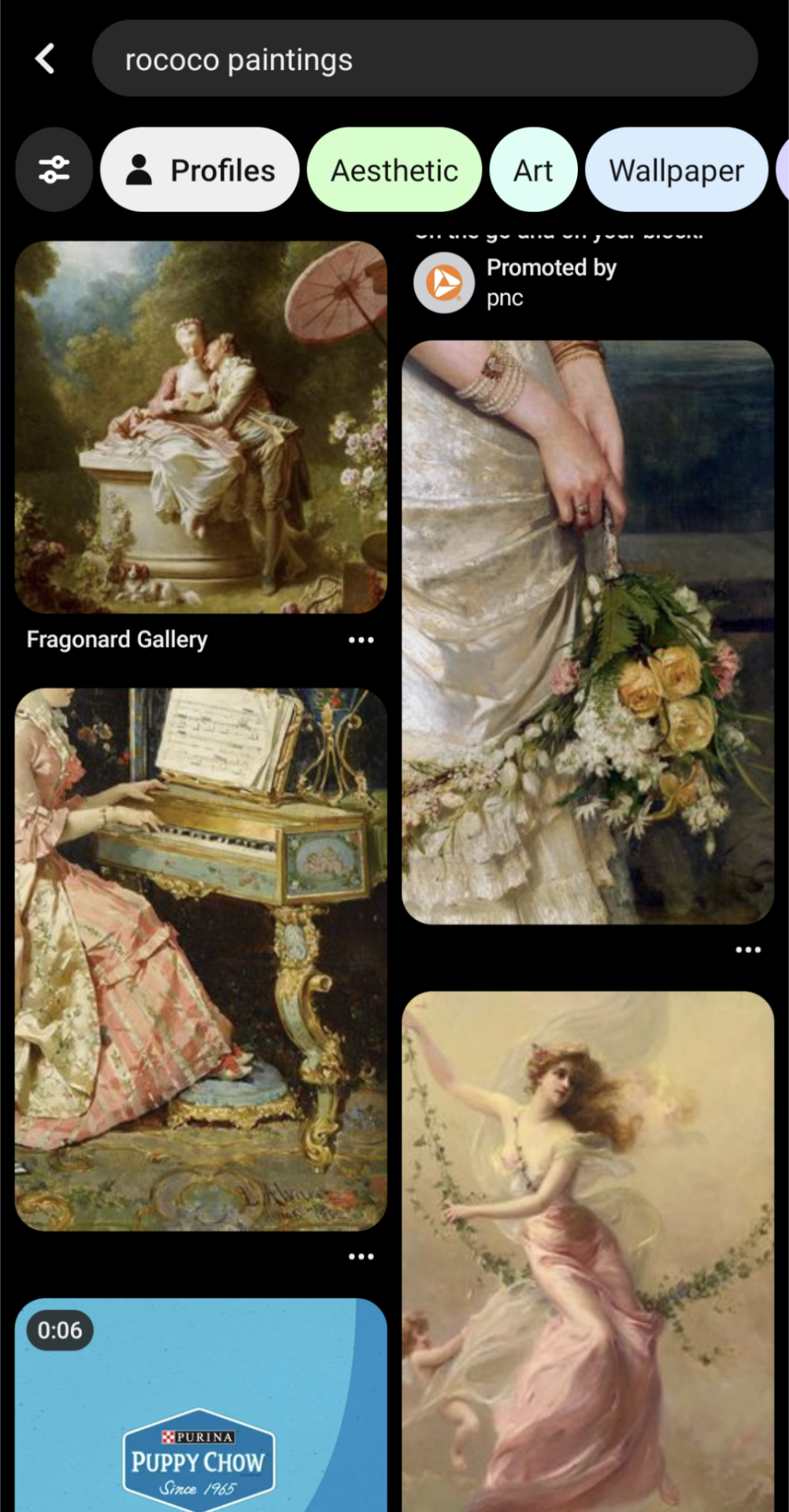
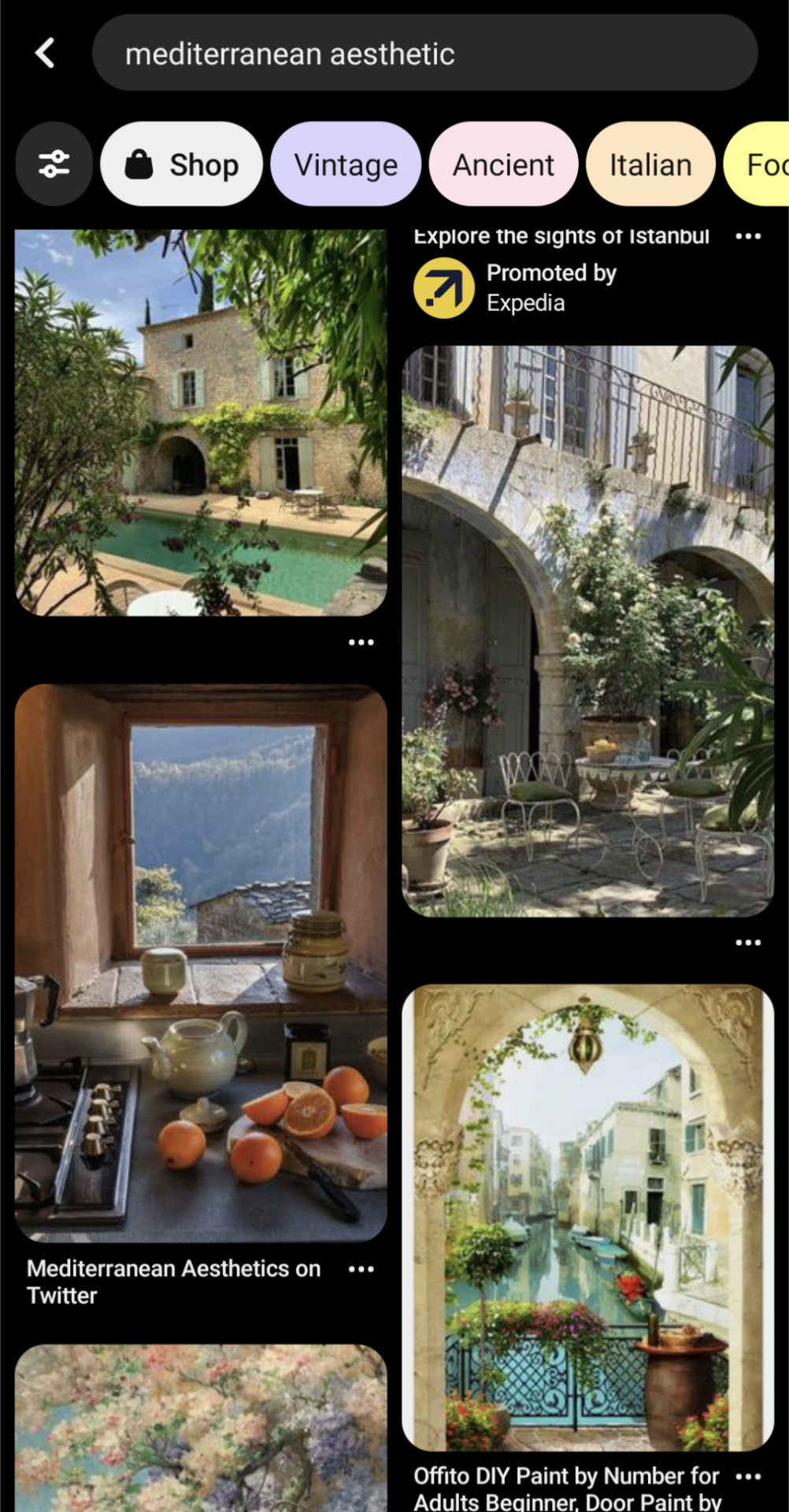
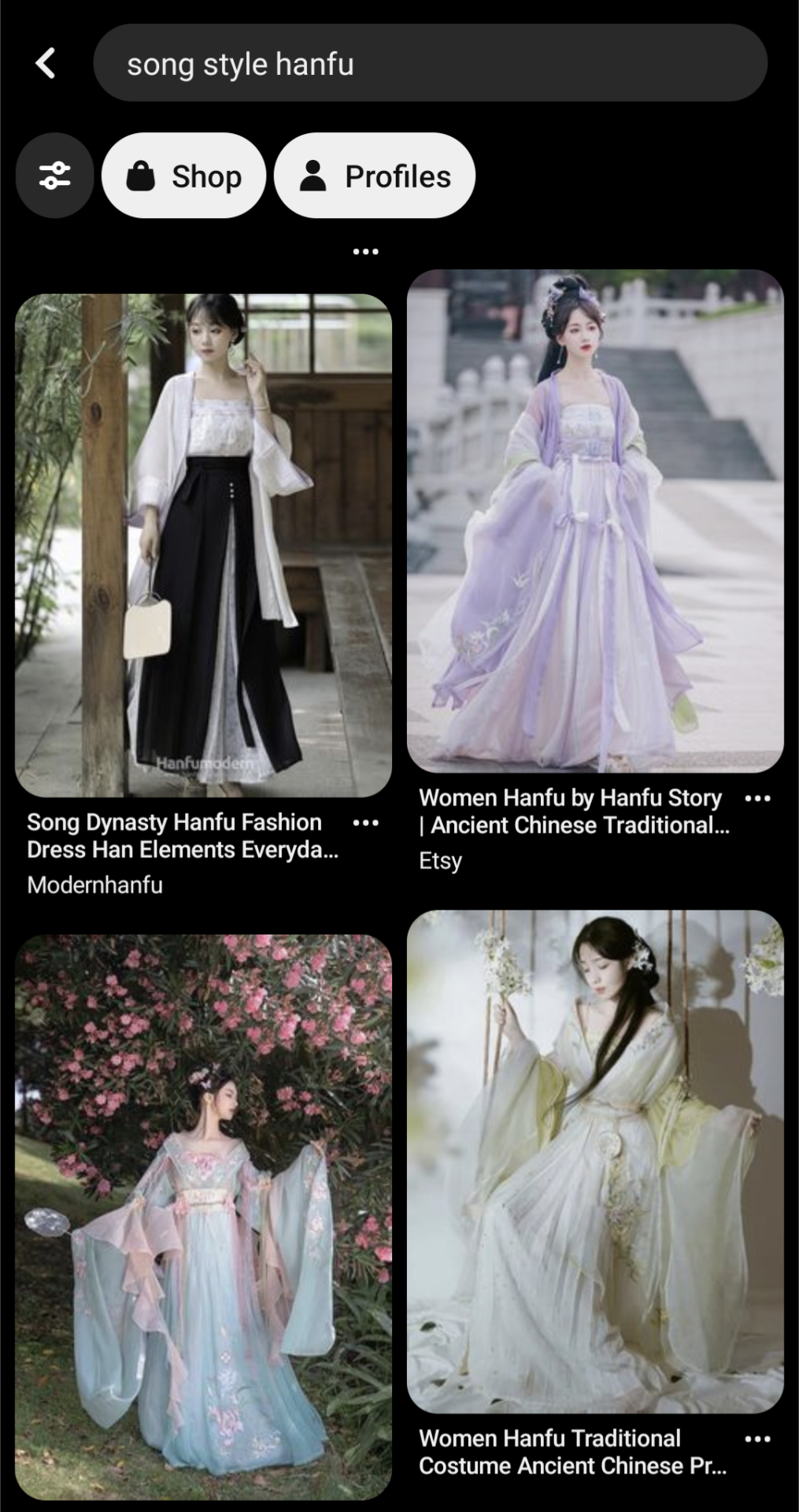
These are pretty specific things, so they find specific things that I want! And after saving them, here is what my feed looked like--chockful of everything I wanted!
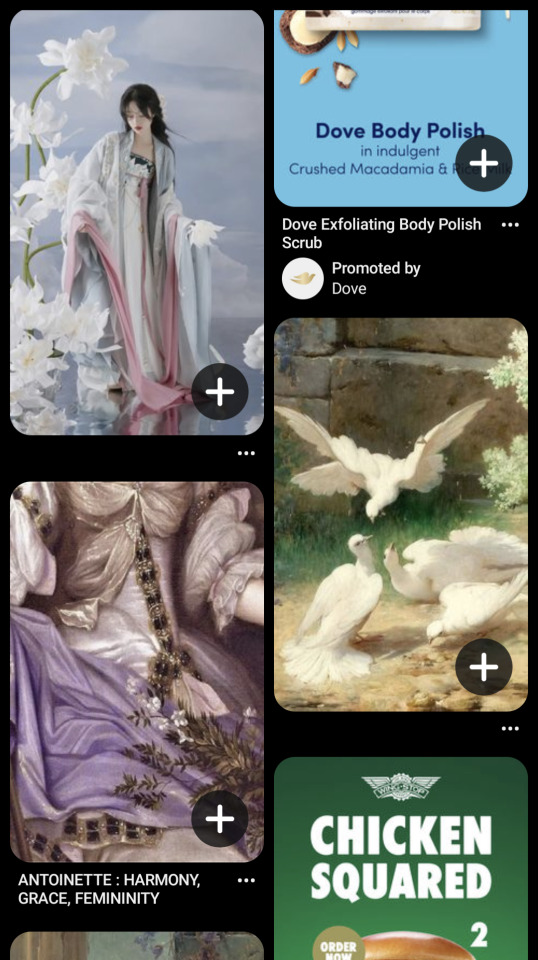
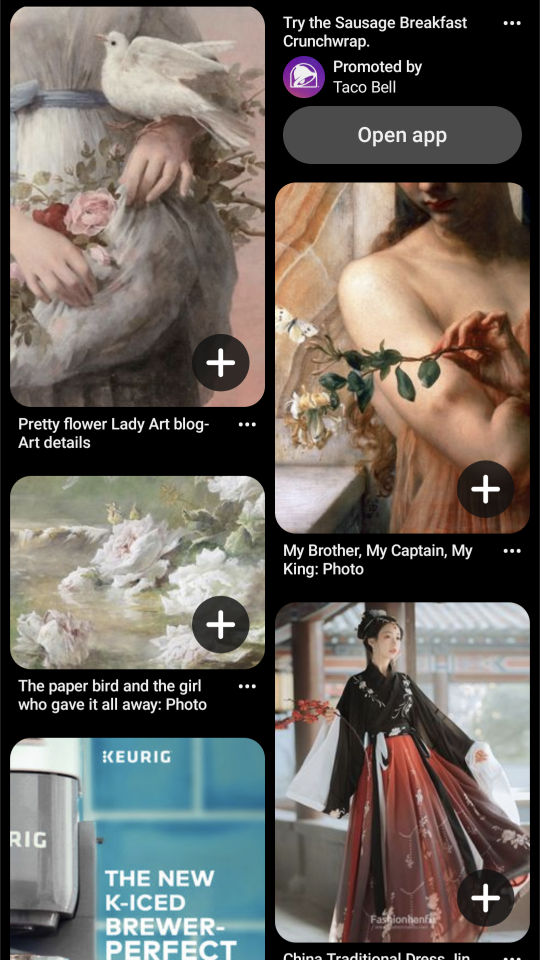
(Tip! If you want board-specific suggestions, aka only finding suggestions from a Pin board you made, go to that board and find "More Ideas"! ✨)
Closing thoughts
I hope this was all useful to you! ♥️♥️ I know it included a little more than you wanted, but I hoped it helped anyway! If you want me to help you look for things, drop me a DM, de-anoned ask (which I can answer privately to you), or even just an anon ask again, and I can help you find some keywords and resources to find. I love doing research!
Thanks for sending an ask 💕💕💕✨
61 notes
·
View notes
Note
what would modern mongolia’s fashion style be like? his hobbies?
I wouldn't see him being too fussed about fashion on a day to day, but he definitely knows how to dress himself. I don't think he goes for bold colours on the daily. He seems to have a practical and understated approach to fashion tbh. I think he prefers comfort and functionality over extravagant styles or anything overcomplicated.
On a typical day, I can see him wearing clothing in muted tones such as deep blues, blacks, and browns etc. His day to day wardrobe consists of comfortable yet durable fabrics, so he can move freely while still looking put together if that makes sense?
Again he's not fussed about thinking too hard about what he wants to wear on a daily so he has classic pieces like trousers, plain shirts, and simple jackets. Accessories I'd say are minimal? Perhaps a sturdy leather belt or a subtle watch/leather bracelet. Jewellery wise, I see him on the silver/steel side. Silver studs/simple necklace but nothing excessive.
When it comes to outerwear, he'd probably opt for a trench coat in a neutral hue like beige or dark gray or a nice leather jacket.
I think he still wears the traditional deel too, but of course not the fancy kind everyday (he doesn't want to ruin them) and not everyday anyways. When he does wear a deel, he wears more like the practical type that nomads wear which is made to be more durable for day to day use.
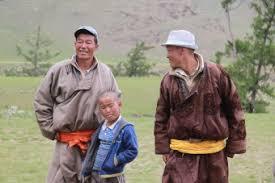
The practical deel in question is crafted primarily from sheep wool and basic materials. It's designed for everyday wear, so it lacks intricate patterns but has a plush, warm texture. Winter deels, in particular, are very robust, with thick layers of sheep wool stuffing inside. They are reinforced with a few buttons near the collar. These deels are capable of withstanding temperatures as low as -40 degrees Celsius.
I think he definitely wears deels more often in the winter time/when he's in the countryside because if they managed to keep him from freezing to death for so long then he's sticking with them. Kind of like a "if it's not broken don't fix it" mentality.
Some hobbies:
The very obvious archery/horse riding/wrestling
Chess! Along with playing mahjong (practicing to beat China)
Logic games in general he's downloaded quite a few on his phone
Falconry
Reading
Wood carving/bow making
Camping/hiking
Calligraphy (Mongolian calligraphy obviously)
Arguing with people on the Internet
This is a headcanon I'm still contemplating tbh but I think it would be sick if he was freakily flexible like a contortionist. Mongolian contortionism is so cool lol
#hetalia#aph mongolia#hws mongolia#hetalia world stars#hetalia world series#hetalia world twinkle#Hetalia Mongolia#Hetalia headcanon#hetalia headcanons#Hetalia hcs#Aph Asia#Hws Asia#Hetalia Asia#Aph east Asia#Hws east Asia#Hetalia east Asia
23 notes
·
View notes
Text
my name is Hazel and I was born on September 17th 1993, at 2:45pm, in San Luis Obispo, California. I’m a college student and I live in the Los Angeles area in a shitty uninhabitable trailer with my 4 cats. I didn’t get any of these cats on purpose but I am an irl Disney princess and cats flock to me when I sing. it is my lifelong dream to murder a man.
things that I like:
my girlfriend aka the coolest and smartest and loveliest woman in the world
faeries
astrology
fashion
true crime/serial killers
ballet
sadomasochism
gore
nature
magic
my friend Oscar
travel
vampires
cats and other animals
Barbie
writing
singing
psychedelics
books
goth clubs
feminism
shoplifting
Taylor Swift
horror movies except I’ve barely seen any of them I just really like the ones my girlfriend shows me
health and fitness
psychology
aerial silks
mongolian bbq
the color pink
things that I don’t like:
men (general)
Johnny Depp (specific)
having impulse control
traditional gender roles
my family
football
my job
group projects
American Psycho
Levi Loggins my ex fiancee and forever enemy
‘queer’ people who aren’t same sex attracted
veganism
people who are stupid
limits
labels
boredom
the concept of empathy
the color gray
I am very spiritual and was raised Wiccan but now follow my own path. I believe in God and magic and witchcraft and faeries and demons and lots of other woowoo shit. I’m a very big believer in the connections between all things in the universe and the magical nature of this. this is inextricable from the way I see the world. I believe stories are a kind of magic as well and as such narrative conventions and archetypes are very important and sacred to me.
on 1/22/24 I astral projected to the 8th dimension and had sex with God and also briefly became God. this experience gave me a lot of insight as to my purpose on this Earth and the nature of life and death. while i was in this state i willed things to happen on earth that did in fact happen. I am trying to go back but have so far been unsuccessful.
I used to be an arsonist and I used to live in the PNW and I used to work on a weed farm
my friend and I are writing an epic dystopian political thriller based on the Barbie animated movies. you can read about it at @historyofgardenia
I’m a lesbian
I live up my own ass
8 notes
·
View notes
Text
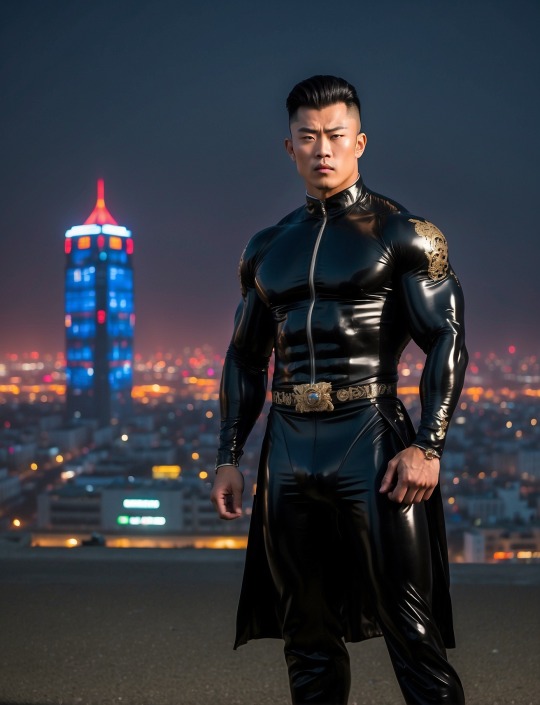
🌟 Welcome to the enchanting realm of Latex Legends League Season 4, where dreams are woven into reality and legends are etched in rubber! 💫 Join us on a mesmerizing voyage as 21 human contenders and 15 AI characters embark on a quest for the prestigious title of Latex Legend.
Now, let's turn our gaze to Erdene, representing Mongolia! 🇲🇳 This visionary fashion designer from the heart of Mongolia brings a unique blend of tradition and modernity to his impressive rubber creations. 🎨✨
With a keen eye for detail and a passion for innovation, Erdene crafts breathtaking ensembles that pay homage to his cultural heritage while embracing contemporary flair. Each of his designs tells a story of resilience, beauty, and the enduring spirit of Mongolia.
As Erdene takes center stage, he invites us to witness the fusion of past and present, tradition and innovation. His exquisite creations captivate the senses, evoking a sense of wonder and admiration.
Join us in celebrating Erdene's journey as he weaves a tapestry of elegance and sophistication in Latex Legends League Season 4. Let's honor his creative genius and embrace the rich tapestry of Mongolian culture! 🎉👘
8 notes
·
View notes
Text
i will say that i think kiawentiio is a great casting choice for Katara, she's a great fit for the character and im super excited to see her perform. i will also say however (and this is no fault of kiawentiio's) that im rly disappointed in the costuming choices regarding Katara specifically
Out of all the pictures of the cast so far, Katara definitely feels the most "costume-y" and unrealistic

The design of the patterned pieces on her coat do not resemble any type of Inuit or otherwise indigenous embroidery that I know of, in fact they aren't embroidery at all (which I find personally offensive because embroidery would've looked SO much better and more natural and would relate it more solidly to the Inuit and indigenous clothing it should be based off of) but they are reminiscent of water tribe designs in the show so I would give them a pass on that technicality. However, it's just so bad looking I really can't let it go. It's ugly! There! I said it! I have no real reason to dislike it other than my own personal preference! So what!
Moving on from the coat, the absolute lack of Inuit inspiration is a lot more apparent in the inner layers/traveling clothes. I understand that the Southern Water Tribe being inspired by Inuit/Inupiat/Yupik culture is a cultural outlier in the rest of the show, where the other nations draw from an amalgamation of East and South East Asian cultures, and the Northern Water Tribe of Mongolian and various Siberian cultures. Katara and Sokka's traveling clothes (both in the og show and the netflix adaptation) seem to be inspired more by East Asian clothing in order to bring their designs more in line with the rest of the show, but the lack of Inuit and indigenous inspiration in any of these new designs (that we've been shown so far at least) really annoys me
To my knowledge, even the inner layers in Inuit garments are commonly made of skins, not cloth, but there are other cold climate cultures that will use fabrics like cotton, wool and silks in their clothing, so I could forgive them (again) if they drew accurately from those designs instead.
Katara's outfit appears (to me) to most likely be based off of the Mongolian Deel, but I think an argument could be made for Qing Dynasty Chinese dress as well as they both wrap around the body to clasp to the side of the chest (the look of the clasps however do not seem to have any basis in anything whatsoever)

However, netflix seems to have gone the same way as the shyamalan movie in choosing what looks like a linen(??) fabric? which really stumps me because, to my knowledge, linen is not a fabric often used in cold climate cultures. While it does have thermoregulatory qualities and works well for insulation, it is much more well known for its cooling capabilities than its warming ones. I understand that, to be true to the show they needed to use fabrics not common in traditional Inuit fashion, but even the Mongolian Deel is much more likely to be made of cotton, wool, silk or skins, so the decision to use it seriously throws me for a bit of a loop.

Katara's iconic "hair loopies" are a reference to a traditional Inuit hairstyle (Nunavut Inuit specifically), but the way they have the braids start so far from her part with those plastic beads just makes it look so unnatural. It might be more accurate to the look of the show but spirits it doesn't look good (also just realized now writing this that her necklace pendant is white too it looks like a plastic bottle cap what the fuck EDIT: you see the difference between the faux fur lining her hood and inside it??? CHEAP OLD NAVY DOLLAR STORE LOOKIN ASS COAT)


Even Kanna, who wears the same hairstyle, has her loops integrated more naturally and they look so much better in general
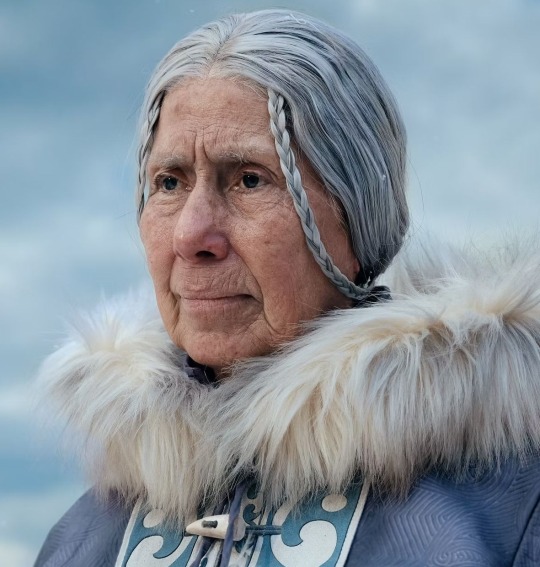
the beads in Katara's hair are not culturally Inuit as far as I know, and instead seem to resemble Tibetan beaded and braided hairstyles. You can see here, though, that they somehow manage to not look like absolute shit and out of place like netflix has Katara's looking (and also are not plastic dental floss white they aren't even white in the show why would they do this to me specifically??)
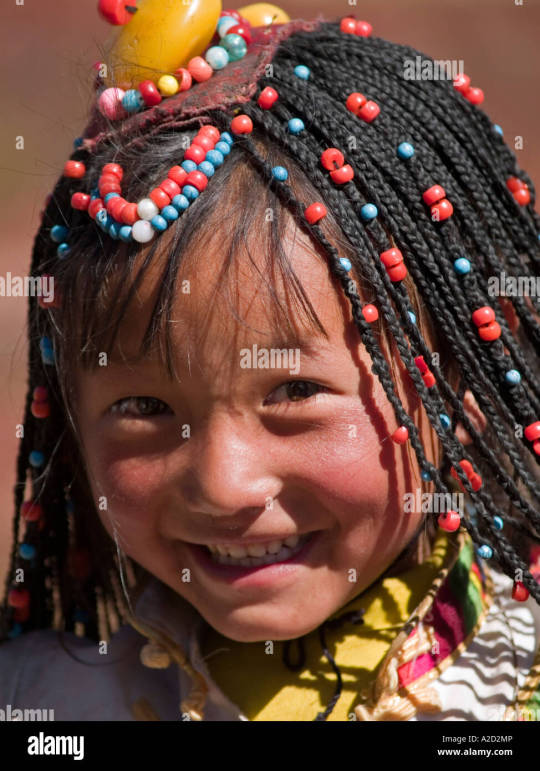

Somehow, the studio producing a franchise live action show cannot make Katara's hair look better than one of those cheap cosplay wigs you can get off aliexpress
It's not hard to make a show-accurate Katara hairstyle work, though. Silvousplaits on YouTube has a great tutorial for a realistic Katara hairstyle that, in my opinion, is somehow better than the multimillion studio hair they've given Katara in the live action

https://youtu.be/tXP-7ja6J_k?feature=shared
Cosplayers are great and devote so much time and talent to making their costumes, but there is absolutely no reason that professionally produced costuming should look worse than something handmade by amateurs that can often only devote so much time to a craft they've picked up outside of their actual careers.
It's ridiculous.
I don't want to prejudge the ATLA live action before it's even out yet, but I already know I'm going to spend the whole time lamenting every single design choice they've made regarding Katara, and the lack of care that I see in her design makes me reticent to watch it.
#these are my PERSONAL OPINIONS and u dont have to agree#but its been bugging me for a while so#if i did get anything wrong tho def feel free to let me know im not an expert or anything#katara#atla#avatar the last airbender#netflix#atla live action#live action#mads talks#kiawentiio
9 notes
·
View notes
Text
Married Mongolian Women’s Hairstyle in the Yuan Dynasty
Mongolians have a long history of shaving and cutting their hair in specific styles to signal socioeconomic, marital, and ethnic status that spans thousands of years. The cutting and shaving of the hair was also regarded as an important symbol of change and transition. No Mongolian tradition exemplifies this better than the first haircut a child receives called Daah Urgeeh, khüükhdiin üs avakh (cutting the child’s hair), or örövlög ürgeekh (clipping the child’s crest) (Mongulai, 2018)
The custom is practiced for boys when they are at age 3 or 5, and for girls at age 2 or 4. This is due to the Mongols’ traditional belief in odd numbers as arga (method) [also known as action, ᠮᠣᠩᠭᠤᠯ, арга] and even numbers as bilig (wisdom) [ᠪᠢᠴᠢᠭ, билиг].
Mongulai, 2018.
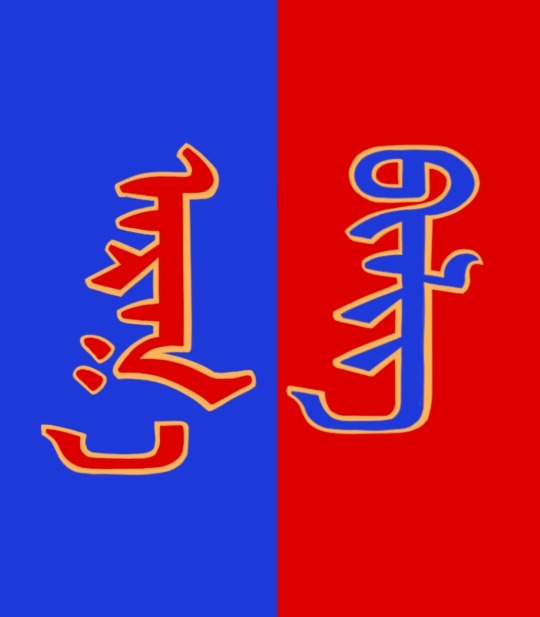
The Mongolian concept of arga bilig (see above) represents the belief that opposite forces, in this case action [external] and wisdom [internal], need to co-exist in stability to achieve harmony. Although one may be tempted to call it the Mongolian version of Yin-Yang, arga bilig is a separate concept altogether with roots found not in Chinese philosophy nor Daoism, but Eurasian shamanism.
However, Mongolian men were not the only ones who shaved their hair. Mongolian women did as well.
Flemish Franciscan missionary and explorer, William of Rubruck [Willem van Ruysbroeck] (1220-1293) was among the earliest Westerners to make detailed records about the Mongol Empire, its court, and people. In one of his accounts he states the following:
But on the day following her marriage, (a woman) shaves the front half of her head, and puts on a tunic as wide as a nun's gown, but everyway larger and longer, open before, and tied on the right side. […] Furthermore, they have a head-dress which they call bocca [boqtaq/gugu hat] made of bark, or such other light material as they can find, and it is big and as much as two hands can span around, and is a cubit and more high, and square like the capital of a column. This bocca they cover with costly silk stuff, and it is hollow inside, and on top of the capital, or the square on it, they put a tuft of quills or light canes also a cubit or more in length. And this tuft they ornament at the top with peacock feathers, and round the edge (of the top) with feathers from the mallard's tail, and also with precious stones. The wealthy ladies wear such an ornament on their heads, and fasten it down tightly with an amess [J: a fur hood], for which there is an opening in the top for that purpose, and inside they stuff their hair, gathering it together on the back of the tops of their heads in a kind of knot, and putting it in the bocca, which they afterwards tie down tightly under the chin.
Ruysbroeck, 1900
TLDR: Mongolian women shaved the front half of their head and covered it with a boqta, the tall Mongolian headdress worn by noblewomen throughout the Mongol empire. Rubruck observed this hairstyle in noblewomen (boqta was reserved only for noblewomen). It’s not clear whether all women, regardless of status, shaved the front of their heads after marriage and whether it was limited to certain ethnic groups.
When I learned about that piece of information, I was simply going to leave it at that but, what actually motivated me to write this post is to show what I believe to be evidence of what Rubruck described. By sheer coincidence, I came across these Yuan Dynasty empress paintings:

Portrait of Empress Dowager Taji Khatun [ᠲᠠᠵᠢ ᠬᠠᠲᠤᠨ, Тажи xатан], also known as Empress Zhaoxian Yuansheng [昭獻元聖皇后] (1262 - 1322) from album of Portraits of Empresses. Artist Unknown. Ink and color on silk, Yuan Dynasty (1260-1368). National Palace Museum in Taipei, Taiwan [image source].

Portrait of Unnamed Imperial Consort from album Portraits of Empresses. Artist Unknown. Ink and color on silk. Yuan Dynasty (1260-1368). National Palace Mueum in Taiper, Taiwan [image source].

Portrait of unnamed wife of Gegeen Khan [ᠭᠡᠭᠡᠨ ᠬᠠᠭᠠᠨ, Гэгээн хаан], also known as Shidibala [ᠰᠢᠳᠡᠪᠠᠯᠠ, 碩德八剌] and Emperor Yingzong of Yuan [英宗皇帝] (1302-1323) from album Portraits of Empresses. Artist Unknown. Ink and color on silk. Yuan Dynasty (1260-1368), early 14th century. National Palace Museum in Taipei, Taiwan [image source].
To me, it’s evident that the hair of those women is shaved at the front. The transparent gauze strip allows us to clearly see their hairstyle. The other Yuan empress portraits have the front part of the head covered, making it impossible to discern which hairstyle they had. I wonder if the transparent gauze was a personal style choice or if it was part of the tradition such that, after shaving the hair, the women had to show that they were now married by showcasing the shaved part.
As shaving or cutting the hair was a practice linked by nomads with transitioning or changing from one state to another (going from being single to married, for example), it would not be a surprise if the women regrew it.
References:
Mongulai. (2018, April 19). Tradition of cutting the hair of the child for the first time.
Ruysbroeck, W. V. & Giovanni, D. P. D. C., Rockhill, W. W., ed. (1900) The journey of William of Rubruck to the eastern parts of the world, 1253-55, as narrated by himself, with two accounts of the earlier journey of John of Pian de Carpine. Hakluyt Society London. Retrieved from the University of Washington’s Silk Road texts.
#mongolia#mongolian#yuan dynasty#mongolian history#chinese history#china#boqta#mongolian traditions#history#gegeen khan#empress dowager taji#mongol empire#William of Rubruck#historical fashion#arga bilig#central asia#central asian culture#mongolian culture#asia
276 notes
·
View notes
Note
formal: What's your OC's formal look? Do they like dressing up? Do they have different looks for different occasions?
Hiiii! Thank you for the ask!! Much appreciated! \ o w o / I hope your week goes well!
OC Asks: Character Design Edition

Nomin doesn't have too much in the way of formal clothing... • w •
Sometimes she likes dressing up because she finds the experience of trying on new clothes and styles to see how it looks on her, but overall, encumbering herself with clothing and fashion is not high on her list. The most she's really done is dressing up for events in Eorzea so far. She never really had too much of the opportunity to dress up when she was on the Steppe because she generally had other things on her mind (but this can change! I still have so many more experiences to write! :> ).
Here's a small collection of some of the things I've made for her that fit the criteria, though. :D


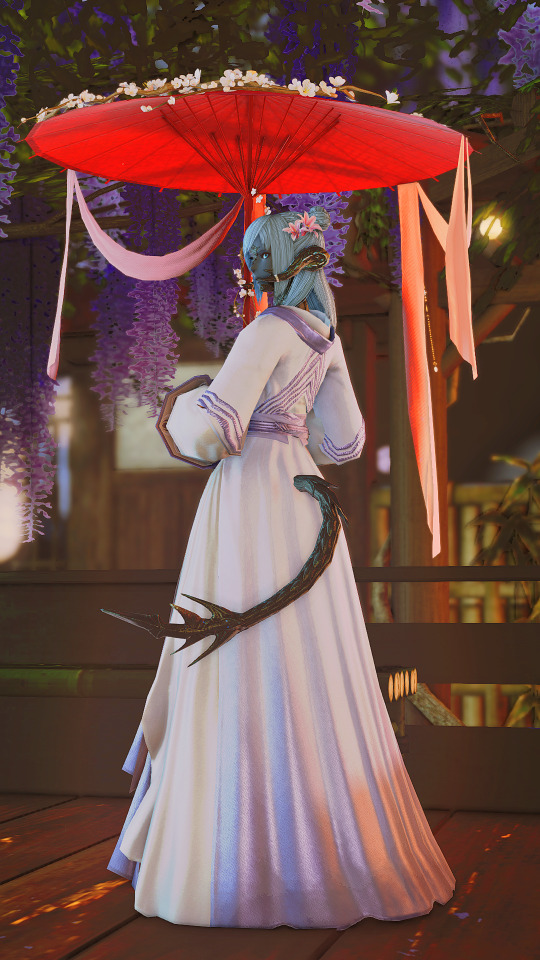

The first outfit is actually the first ever formal outfit I made for Nomin. Just something I thought looked nice.
Second outfit is probably the closest I can get to traditional Mongolian formal wear without mods that she can wear on the Steppe and to celebrate her roots? So I'll mark that as a win in my book since it's really hard to actually make a proper looking deel with what we have available.
Third outfit is a hanfu mashup. As I stated, it's really hard to make proper looking Mongolian clothing. From what I understand, pending on locale on the Steppe, there are some clothes for formal wear that kind of look like a hanfu? It's not terribly ideal for me, though I went with it.
Last outfit is what I kind of imagine Nomin to wear for hers and Estinien's cultural exchange of Eternal Bonding. I have the Steppe version, but I'm not wild about it. So I'll probably sit down and try to tweak it. But this is the Ishgardian version that I chose. Dress mod can be found here.

#questions and answers#user: marceandrowan#thank you ♥#ffxiv#ffxiv screenshots#my screenshots#ffxiv oc#oc: nomin tal kheeriin#... i guess four formal outfits isn't necessarily a small amount?#i'm also just really used to having characters that are VERY fashion conscious#like manaka or primam#who have a LOT of different formal outfits
7 notes
·
View notes
Text
Quick thought before class: This isn't a callout or trying to insult any specific fic or comic or anything, but I've noticed a big trope with fics dealing with Arthur - Wang Yao relations or the Opium Wars, where Arthur is talking about progress but Wang Yao only cares about tradition, has no interest in the west, has stayed the same for thousands of years and therefore has no intention of changing.
So, portraying China as traditionalist isn't bad or even 100% wrong, but imo given the specific time period it deserves careful handling - the idea of China being overly traditionalist, unchanging for thousands of years, and isolated from outside/European contact and influence has been long used as an excuse for the Opium wars as a necessary evil to break open an old Empire that refused to modernize. The idea of a 'thousands of years unchanging empire' is used in all sorts of propaganda on all sides of the argument for different purposes, but it's just not true.
In reality, although there are certainly periods in time when countries and cultures revert to conservatism or self isolate, countries and cultures cannot keep that up for such extended periods of time. The China of the Ming dynasty was not the same as the China of the Qing dynasty, traditionalist or not time moves forward and brings a stream of often radical change that are then absorbed. In the first place, the original Macartney Embassy was sent to Qianlong whose reign is generally considered the height of the Qing empire, in culture, trade, and expansion. Even before his reign, China was developing an interest and taste for western goods, Qianlong himself was a great appreciator of automation and had a good understanding of Britain's military and technological power, one that the Qing would attempt to emulate again and again through reform and buying ships/weapons. A big part of why that failed was more due to internal corruption among the court and officials. The Qing traded closely with the Portuguese, as most people who write about this know, but also had extensive trade relations across Asia - when the emperor received Macartney, Macartney was only one of many dignitaries, many of them being from South Asia. Popular art and fashion also displayed a level of fascination with western patterns, styles, designs, etc. which makes sense - the wars happened because of a trade deficit, not because there was no trade.
And then of course there's the fact that the Qing dynasty was in no way traditional - it was ruled by formerly foreign Manchu and that was reflected in everything from fashion to language to custom, where you could see a sort of melding of Chinese and Manchu (and Mongolian) culture. To Wang Yao, the clothing he's wearing and some customs likely demanded of him as a semi-divine court figure is anything but traditional. Also - China had guns! They were nothing against European guns but the country that produced gunpowder wasn't unaware or unable to innovate their own rendition around a similar time as the European gun.
After all that rambling here's the thesis: even with his long life, I don't necessarily think Wang Yao would be experiencing the time period as some sort of traditionalist continuation. Sure, he's lived long enough to see patterns and the Qing may fall into those patterns, but he's not living in isolated naivety, but rather a rapidly changing world that his people seem happy to move along with. The portrayal of late Qing Wang Yao as refusing to change while observing the west/Arthur as changing due to personal arrogance rather than the huge amounts of internal strife and corruption that was tearing the empire apart from the inside feels inaccurate, as well as centers European actions and awareness as the center of even Wang Yao's outlook and decisions, ignoring both China's internal politics and its relations with the rest of Asia outside of a European context. I can appreciate how the more simplistic portrayal draws compelling parallels between young and old, modern empire and ancient empire, but with the context of how this impression exists due to misinformation and orientalism, I think it deserves a slightly more in-depth depiction.
39 notes
·
View notes
Text
continuing to play stormblood. i have really enjoyed running around the azim steppe and doing all the people’s errands, chatting with them and learning about them, meeting the lesbian, and im also really in love with traditional mongolian fashion now. however. um. im sure other people have spoken about this. but it really is shocking how much this is basically a racist fantasy novel trope. hien is the Chosen Prince who goes to another country, adopts himself into a Downtrodden And Meek Clan, and then leads that clan to victory against the Violent Mean Clans so he can take control of their warriors by right of THEIR traditions and take them to his homeland to further his own political ends. AND YOU HAVE TO HELP HIM DO THIS! right after the naadam when the game has you /victorypose to the mol warriors and they all go YAAAAAAAY YOURE OUR KHATUN!!! WE LOVE YOU!!!! i was just like. AUUUUUGH NOOOO. I DON’T WANT THIS
there are so many other ways to do this... even little tiny tweaks so it isn’t so outrageous. you could convince each clan using diplomacy or diplomatic duels to lend their aid to the anti-imperial cause! you could aid the mol and guard cirina as she claims the ovoo! hell, this isn’t perfect, but what if hien had spent most of his life living on the steppe instead of like... six months?
that last one ties back to one of my other major discomforts with stormblood: lyse. there’s the biggest glaringest obviousest problem of her being the only white/blonde/blue-eyed ala mhigan, but also the fact that she’s our npc viewpoint on the ala mhigan struggle... but she has very few concrete connections to ala mhigo and has never actually lived there (if i’m remembering right - yda took her to live in sharlayan at age 5?). and a lot of the time, she’s our audience surrogate for getting Explained colonial oppression by somebody else in a resistance group after she blusters about “i don’t get it!! why don’t they fight back!!!” . i’m not going to go into the politics of diaspora and liberation struggles because that is something that is 1. far out of my lane 2. very very subjective especially wrt Real Life and not Fantasy Allegory. but it’s just an deeply weird and bad-optics character (very White Savior optics) and storyline. i’m sure other people have written much more coherently and in-depth-ly about the problems with lyse, so i won’t go too much into it here.
lyse and hien are two foils to each other within the text - the Chosen One who must Return To Lead the Liberation of Their Oppressed Homeland after spending time in other nations doing other work. and what’s really strange is that their character backstories would work better if they were switched. hien as the young man who spent most of his life as a warrior of the steppe; he literally says he doesn’t remember a free doma, because he was literally a fetus when doma was conquered - what if he only has memories from childhood of doma? he lived there when he was a small child, and thus still has an emotional investment in doma, but he also has a place on the azim steppe. and lyse as a recent refugee from ala mhigo - her sister rescuing her from some kind of major peril and bringing her to sharlayan or eorzea, leading to her involvement with the scions. the ala mhigan resistance seems much more active and current at the start of stormblood than the doman liberation front: it makes sense to have a character who just came from there be paired with it, and for the relatively more quelled DLF to be trying to bring in their long-lost prince as a last-ditch effort to rally the people before a figurehead after his father was killed in their last rebellion.
obviously any story that borrows so much allegorically from real political struggles is going to have some snarls and problems upon which to think critically. especially when that story is created by a team from a country that has been an imperial and colonial aggressor (as well as been subject to imperial powers itself).
it’s most keenly deeply uncomfortable (to put it lightly) when so much of xaela culture in FFXIV is borrowed from real mongolian cultures. the naadam is a real thing, but it’s not a Glorious Battle To See Who Rules The Steppe, it’s a traditional athletic/training festival. an ovoo is a real type of shrine/altar used in mongolian folk religion. the wikipedia page is right here. the azim steppe is not painted in a wholly negative light, and as always the sidequests give you a lot of sympathy and texture to the people in the area, but the borrowing from real mongolian culture is... well: imperial japan literally tried to seize mongolian religious relics when it was occupying china! this is not a clean slate that squeenix is working on.
stormblood gives you a lot to think about, and a lot of it isn’t good. it’s a story about resisting imperialism and how to go about doing that, which is bound to get people thinking and arguing. ffxiv is certainly a more politically incisive story about imperialism than star wars and many other pieces of genre fiction, but it’s also far from the most leftist story in the world. there are other problems within the game’s politics as of stormblood: most glaringly, the “beast tribes” (i am looking forward to that improving as ive heard it does in later expansions).
i’m obviously far from the best person to talk about this subject (white american), which is why i’m giving a stream-of-consciousness mini-essay on my personal tumblr blog, rather than publishing a book/article or otherwise getting paid to speak on this, or inserting myself where i shouldn’t be. but i do think that it’s not a bad thing for anyone playing ffxiv to think about stuff like this, so i am putting on my critical thinking cap and posting about it. as one does on their personal blog.
UPDATING EDIT SECTION: went out googling for more informed takes on this and here’s an article that talks about the problems with the azim steppe storyline way more incisively than my natural rhetoric.
26 notes
·
View notes
Note
Hi! I was wondering what you searched up for your outfits post (especially the riverlands)! I’m making a pinterest board for my AU and I’m fr struggling
Hey!! Okay so I also use Pinterest for everything. Most of my searches ended up being like “Tudor fashion” “traditional Russian clothing” “historical Mongolian clothing” etc etc. And then I go from there by clicking a pin I like and seeing if the recommended ones under it are going for the vibe I like. Sometimes it does take a while to find ones that fit the vibes I’m going for 😭 I think I just plugged “medieval clothing” for my riverlands one and just went from there. Sometimes u really gotta scroll for a while 💔
10 notes
·
View notes